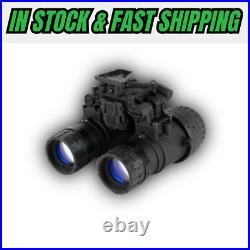


The AB Night Vision ARNVG is a big game changer to the market due to its construction and features. This unit is crafted out of 7075 aluminum like the. It also has very similar features to the. Such as its ability to independently pivot the pods away from the center of the housing, as well as having an individual cut off which cuts power to the image intensifier by rotating the pods away from the center of the housing, and this unit runs off a single CR123 battery up to 18 hours of use. We offer customers the option to view our.
You will be able to view images through the unit, the specifications for the unit, and be able to select the one that works for you. If you have questions, or don't know what will work for you, you can always chat with us in our live chat, or give us a call and we would be more than happy to figure out which system will best fit your specific needs. Image Intensification tube specification designation, calculated on line pair per mm x signal to noise. The ability of an image intensifier or night vision system to distinguish between objects close together.
Image intensifier resolution is measured in line pairs per millimetre (lp/mm) while system resolution is measured in cycles per miliradian. For any particular night vision system, the image intensifier resolution will remain constant while the system resolution can be affected by altering the objective or eyepiece optics by adding magnification or relay lenses. Often the resolution in the same night vision device is very different when measured at the centre of the image and at the periphery of the image. This is especially important for devices selected for photograph or video where the entire image resolution is important. Measured in line pairs per millimetre (lp/mm).
SNR (Signal to Noise Ratio). A measure of the light signal reaching the eye divided by the perceived noise as seen by the eye. A tube's SNR determines the low light resolution of the image tube; therefore, the higher the SNR, the better the ability of the tube to resolve objects with good contrast under low-light conditions.
Because SNR is directly related to the photocathode's sensitivity and also accounts for phosphor efficiency and MCP operating voltage, it is the best single indicator of an image intensifier's performance. This is the amount of light you see through a night vision device when an image tube is turned on but no light is on the photocathode. EBI is affected by temperature; the warmer the night vision device, the brighter the background illumination. EBI is measured in lumens per square centimeter (lm/cm2).
The lower the value the better. The EBI level determines the lowest light level at which an image can be detected. Below this light level, objects will be masked by the EBI. Halo is the circular region around a bright light that appears "brighter" - It's caused by elastic collisions of electrons with the MCP surface which subsequently then bounce off and down another hole.
Photocathode sensitivity is a measure of how well the image intensifier tube converts light into an electronic signal so it can be amplified. The measureing units of photocathode sensitivity are micro-amps/lumen (µA/lm) or microamperes per lumen. This criterion specifies the number of electrons released by the Photocathode (PC). PC response is always measured in isolation with no amplification stage or ion barrier (film). Therefore, tube data sheets (which always carry this "raw" figure) do not reflect the fact that over 50% of those electrons are lost in the ion barrier. While for most latest 3rd generation image intensifiers the photoresponse is in the 1800 µA/lm (2000 µA/lm for the latest Omni VI Pinnacle tubes), the actual number is more like 900 µA/lm. Also called brightness gain or luminance gain. This is the number of times a night vision device amplifies light input. It is usually measured as tube gain and system gain. Tube gain is measured as the light output (in fL) divided by the light input (in fc). This figure is usually expressed in values of tens of thousands. If tube gain is pushed too high, the tube will be "noisier" and the signal-to-noise ration many go down. Military Gen 3 image tubes operate at gains of between 20,000 and 45,000. On the other hand, system gain is measured as the light output (fL) divided by the light input (also fL) and is what the user actually sees. System gain is usually seen in the thousands. Military systems operate at 2,000 to 3,000. In any night vision system, the tube gain is reduced by the system's lenses and is affected by the quality of the optics or any filters. Therefore, system gain is a more important measurement to the user. Approximately 18 hours of battery life on a CR123 battery. Assembled in house with our accredited ISO 9001:2015 process and procedures. 576 g (21.3 oz).


